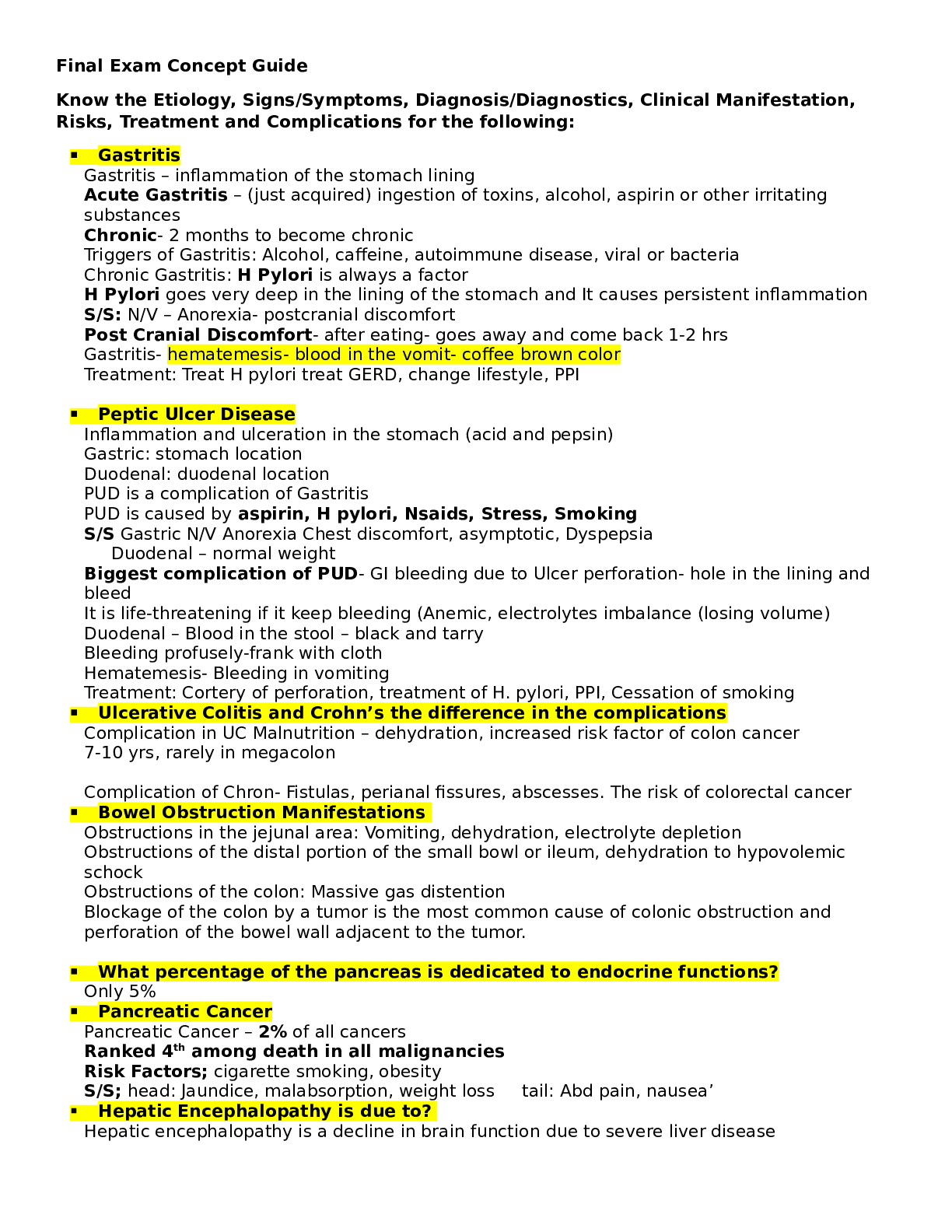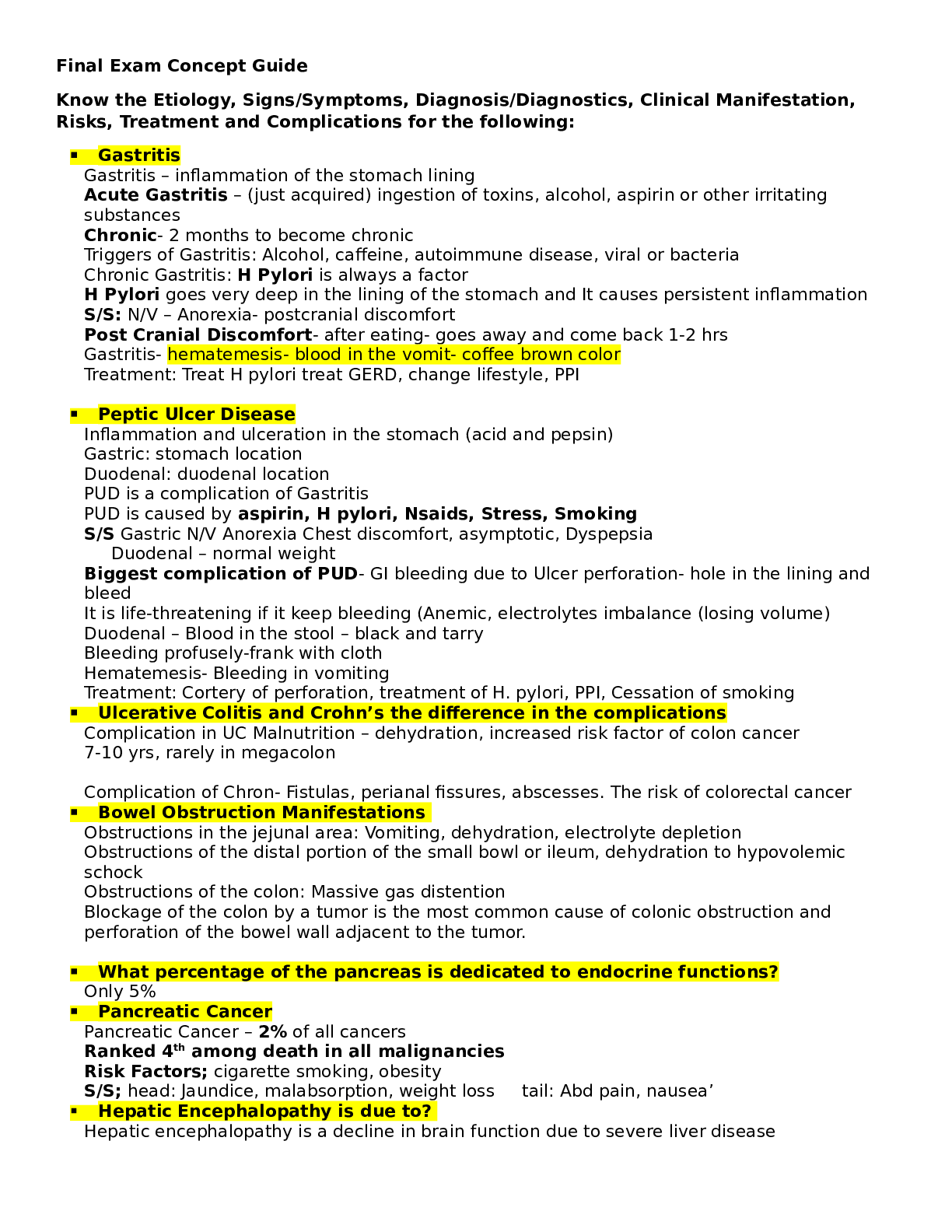Know the Etiology, Signs/Symptoms, Diagnosis/Diagnostics, Clinical Manifestation,
Risks, Treatment and Complications for the following:
Gastritis
Gastritis – inflammation of the stomach lining
Acute Gastritis – (just acquired) ingestion of toxins, alcohol, aspirin or other irritating
substances
Chronic- 2 months to become chronic
Triggers of Gastritis: Alcohol, caffeine, autoimmune disease, viral or bacteria
Chronic Gastritis: H Pylori is always a factor
H Pylori goes very deep in the lining of the stomach and It causes persistent inflammation
S/S: N/V – Anorexia- postcranial discomfort
Post Cranial Discomfort- after eating- goes away and come back 1-2 hrs
Gastritis- hematemesis- blood in the vomit- coffee brown color
Treatment: Treat H pylori treat GERD, change lifestyle, PPI
Peptic Ulcer Disease
Inflammation and ulceration in the stomach (acid and pepsin)
Gastric: stomach location
Duodenal: duodenal location
PUD is a complication of Gastritis
PUD is caused by aspirin, H pylori, Nsaids, Stress, Smoking
S/S Gastric N/V Anorexia Chest discomfort, asymptotic, Dyspepsia
Duodenal – normal weight
Biggest complication of PUD- GI bleeding due to Ulcer perforation- hole in the lining and
bleed
It is life-threatening if it keep bleeding (Anemic, electrolytes imbalance (losing volume)
Duodenal – Blood in the stool – black and tarry
Bleeding profusely-frank with cloth
Hematemesis- Bleeding in vomiting
Treatment: Cortery of perforation, treatment of H. pylori, PPI, Cessation of smoking
Ulcerative Colitis and Crohn’s the difference in the complications
Complication in UC Malnutrition – dehydration, increased risk factor of colon cancer
7-10 yrs, rarely in megacolon
Complication of Chron- Fistulas, perianal fissures, abscesses. The risk of colorectal cancer
Bowel Obstruction Manifestations
Obstructions in the jejunal area: Vomiting, dehydration, electrolyte depletion
Obstructions of the distal portion of the small bowl or ileum, dehydration to hypovolemic
schock
Obstructions of the colon: Massive gas distention
Blockage of the colon by a tumor is the most common cause of colonic obstruction and
perforation of the bowel wall adjacent to the tumor.
What percentage of the pancreas is dedicated to endocrine functions?
Only 5%
Pancreatic Cancer
Pancreatic Cancer – 2% of all cancers
Ranked 4th among death in all malignancies
Risk Factors; cigarette smoking, obesity
S/S; head: Jaundice, malabsorption, weight loss tail: Abd pain, nausea’
Hepatic Encephalopathy is due to?
Hepatic encephalopathy is a decline in brain function due to severe liver disease
Hepatic encephalopathy is usually precipitated by certain well-defined clinical developments,
including hypokalemia, hyponatremia, alkalosis, hypoxia, hypercarbia, infection, use of sedatives,
GI hemorrhage, protein meal gorging, renal failure, and constipation. In some patients,
progressive liver failure leads to chronic encephalopathy without other exacerbating factors.
Hepatic encephalopathy is graded 1 to 4:
Grade 1: Confusion, subtle behavioral changes, no flap
Grade 2: Drowsy, clear behavioral changes, flap present
Grade 3: Stuporous but can follow commands, marked confusion, slurred speech, flap
present
Grade 4: Coma, no flap
Gastroesophageal Varices Management
- Initial treatment: Fluid resuscitation to stop bleeding
- Large bore intravenous lines are placed
- Admin of parenteral vitamin K and plasma, platelet infusion if thrombocytopenia is
present
- Octreotide acetate (synthetic analog) no more vasopressin 3-5 days
- Metoclopramide and B blockers
- Esophagogastroduodenoscopy EGD to determine site of bleeding
Difference between Diverticulosis and Diverticulitis
Diverticulosis (diverticular disease) presence of diverticula in the colon.
Diverticula are acquired herniations of the mucosa and submucosa through the muscular coat
of the colon
Diverticulosis The presence of one or more diverticula vs diverticulitis inflammation of one or
more diverticula
Kidney Disease- Assessment-CVA
Pain associated with intrarenal disorders are assessed by palpating or light percussion over
the costovertebral angle (CVA) posteriorly and is recorded as CVA tenderness. Pain is
transmitted to the spinal cord between T10 and L1
Kidney Cancer signs and symptoms
Benign renal neoplasm: S/S Hematuria and flank pain
Some may be asymptomatic until large
Renal cell carcinoma: Metastatic disease
Risk factors: smoking, obesity and hypertension
S/S CVA tenderness, hematuria, palpable mass
Read More


